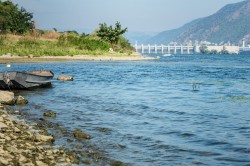Press Release, 03. December 2019
How to improve water quality in Europe
Policy briefs provide decision-makers with recommendations for action
Toxic substances from agriculture, industry and households endanger water quality in Europe - and by extension, ecosystems and human health. As part of the SOLUTIONS project, over 100 international scientists - coordinated by the Helmholtz Centre for Environmental Research (UFZ) - have developed methods and practical solutions for identifying pollutants and assessing the risks posed by chemical cocktails. This is intended to help reduce pollution in water resources. Researchers have described how politicians can implement these scientific results in 15 policy briefs, which have now been published in the Environmental Sciences Europe journal.

Photo: André Künzelmann / UFZ
The EU Water Framework Directive (WFD) adopted in 2000 aims to protect Europe’s water resources. By 2027, EU Member States are required to bring all water bodies into a "good ecological" and "good chemical state". There’s still a long way to go. This is due, for example, to the fact that a few existing substances, for which there are currently no suitable possibilities for reducing pollution, lead to environmental quality standards being exceeded across the board in Germany and Europe - and thus to poor water quality. "What’s more, the complex mixtures of pesticides, medicines and industrial chemicals that are released daily and pose a considerable risk for humans and the environment are not taken into account when establishing the chemical status of our water bodies," says UFZ Environmental Chemist Dr Werner Brack, who coordinated the SOLUTIONS project that drew to a close last year. The current WFD indicator system does not differentiate between rivers with differing pollution nor does it demonstrate any actual improvements in water quality as a result of any measures implemented. This is why it urgently needs to be developed further. Otherwise, according to Brack, the objectives of the WFD cannot be achieved.
For the past five years, European scientists have carried out research as part of the SOLUTIONS project, which received EUR twelve million from the EU. "It has been shown that the current practice of limiting the assessment of chemical pollution to a few substances defined as priorities throughout Europe and certain river-basin-specific pollutants is not sufficient for recording pollution as a whole," summarises Werner Brack. At present, the WFD only lists 45 priority pollutants that are not allowed to occur or occur only to a limited extent in water bodies categorized as water bodies of good quality. However, more than 100,000 chemical substances end up in the environment and water bodies. The indicators currently used to assess water quality cannot be used to identify pollution hotspots or initiate appropriate management measures. The SOLUTIONS project has therefore developed new concepts and tools for monitoring and reducing exposure to complex mixtures.
In a total of 15 policy briefs, SOLUTIONS researchers have set out how policy makers can implement these concepts and tools. For example, scientists recommend that substances in toxic mixtures should also be taken into account when prioritising chemicals under the WFD. Until now, prioritising chemicals and defining EU-wide priority and river-basin-specific substances have only been based on individual chemicals. In another policy brief, they describe how users can use the RiBaTox toolbox developed as part of the SOLUTIONS project to solve problems related to the monitoring, modelling, impact assessment and management of chemical mixtures in surface waters. Monitoring methods should be used to target the complex mixtures, i.e. effect-based methods that involve representative aquatic organisms such as algae, small crustaceans, fish embryos and suitable cell systems demonstrating how toxic each chemical cocktail is. This would allow toxic loads to be determined, even if the underlying chemicals are unknown or below the detection limit for analysis. These methods should be complemented by chemical screening techniques using high-resolution mass spectrometry to see which substances the mixtures contain, to detect emerging chemicals and to monitor pollution trends in the aquatic environment. This way, valuable information can also be collected on the occurrence of substances that are now detectable but cannot yet be identified. To be able to use this extensive data on hundreds and thousands of substances in water to assess the risk of chemical cocktails, the authors also suggest establishing a European data infrastructure. This will help gather data and make it accessible to the world of science and the authorities so it can be evaluated and shared.
"The policy briefs are intended to make it easier for decision-makers to access the scientific information needed to protect Europe’s water resources," says Werner Brack. This is an important basis for people’s health across Europe and for healthy ecosystems that provide the population with key services.
Publications:
Brack (2019): Solutions for present and future emerging pollutants in land and water resources management. Policy briefs summarizing scientific project results for decision makers. Environmental Sciences Europe 2019, https://enveurope.springeropen.com/articles/10.1186/s12302-019-0252-7
All policy briefs: https://www.springeropen.com/collections/solutions
Further information
PD Dr. Werner Brack
Head of UFZ Department Effect-Directed Analysis
werner.brack@ufz.de
UFZ press office
Susanne Hufe
Phone: +49 341 6025-1630
presse@ufz.de
In the Helmholtz Centre for Environmental Research (UFZ), scientists conduct research into the causes and consequences of far-reaching environmental changes. Their areas of study cover water resources, ecosystems of the future, environmental technologies and biotechnologies, the effects of chemicals in the environment, modelling and social-scientific issues. The UFZ employs more than 1,100 staff at its sites in Leipzig, Halle and Magdeburg. It is funded by the Federal Government, Saxony and Saxony-Anhalt.
www.ufz.deThe Helmholtz Association contributes to solving major challenges facing society, science and the economy with top scientific achievements in six research fields: Energy; Earth and Environment; Health; Key Technologies; Matter; and Aeronautics, Space and Transport. With some 39,000 employees in 19 research centres, the Helmholtz Association is Germany’s largest scientific organisation.
www.helmholtz.de